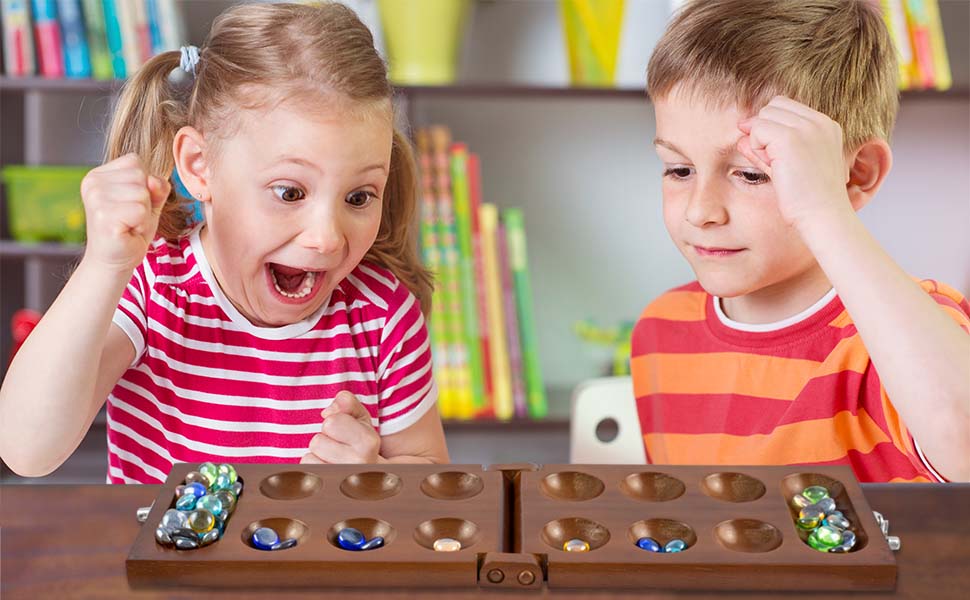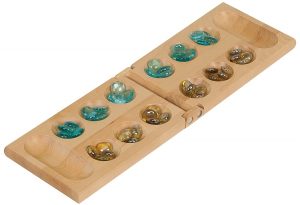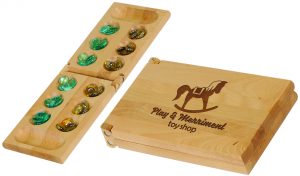Manca…what? If you have no idea what mancala is, you’re not alone. After all, mancala sounds more like the name of a character from Disney’s The Lion King than anything else, right?
Pronounced man-KAH-la, mancala is an easy-to-learn game that has been around for centuries. Despite being a game that has stood the test of time, many people still aren’t familiar with this entertaining pastime.
History of the Game
Actually, if you thought that mancala was a character from The Lion King, you weren’t that far off! Archaeologists have found evidence of mancala games going back thousands of years in the region of North Africa and the Mideast. The game became popular throughout Arabia, Africa, and Asia and spread from there. Needless to say, this game has long-lasting appeal for people of all ages and backgrounds!
Mancala is often referred to as a “seed and pit” game. Originally, people would dig little pits into the ground to make the game board and then use seeds or stones as the game pieces. According to the Oxford Dictionary, the Arabic word manqala means a “(device designed for) transfer (of board-game pieces from one position to another)” and the word naqala means to transfer, remove, or relocate.
In a nutshell, game pieces are moved from one pit to the next, and the person with the most pieces in his or her large pit (or mancala) at the end of the game, wins.
Nowadays, mancala boards are often crafted from wood or plastic, but the concept is the same. The game board consists of twelve small pits with two large pits (mancalas) at either end of the board. Rather than seeds or stones, modern mancala games use glass or plastic pebble-shaped pieces or marbles for game play.
Rules of Play

Kids love to play Mancala!
Mancala is an easy game to learn and play, making it fun for people of all ages and stages. It is a simple, two-player game. And here’s a bonus: mancala doesn’t take that much time to play! You can complete a game in less than fifteen minutes.
Need a brain break at work? Keep a mancala set on your desk and use it to help clear your mind.
Looking for a game that will entertain a child with a short attention span? Play mancala!
Here are the rules for playing mancala:
Game Set-Up
- Place the game board horizontally, so that each player has six pits in front of them and so the players are facing each other.
- The large pit to each player’s right is his or her mancala, or store. The object of the game is for each player to get as many game pieces as possible in his or her large pit. The person with the most pieces in his or her mancala at the end of the game wins.
- Put four game pieces in each of the twelve small pits before beginning the game. The large pits, or mancalas, should be empty to start the game.
Basic Play
- Choose who will go first. Player 1 will select one of the six pits directly in front of him or her and remove all four pieces. Next, the player will transfer the stones, one at a time, in each pit going in a counter-clockwise direction until they are all gone.
- Player 2 will do the same, choosing a pit from the row in front of him or her and redistributing the stones in the pits, going in a counter-clockwise direction.
- Players will always place a stone in their large pit but will skip over the large pit of his or her opponent. Players never place stones in their opponent’s mancala.

Rules to Note
As the pieces are deposited around the board, there are a couple of special rules to follow:
- If the last stone in a player’s hand is placed in his or her large pit, then the player earns an extra turn.
- If the last stone in a player’s hand is placed in an empty pit on his or her side of the board, then the player gets to capture all the stones in the pit directly across from it! When stones are captured, they are added to the player’s large mancala.
End of the Game
- The game ends when one player has emptied the six pits of stones on their side of the game board.
- The other player gets to take all the remaining stones on his or her side and place them into their store, or mancala.
- Each player counts the number of pieces in their large pit. The player with the most stones wins the game!
As you can see, mancala is clean and simple in form. There are not many rules to remember, but a strategy is needed! After playing a few times, you will learn what sequence of moves will help you earn extra turns, capture your opponent’s pieces, and preserve your stones for the end of the game.
In fact, this ancient game is fabulous for helping children develop counting skills and the ability to predict moves and think ahead. As with many math-based games involving strategy, mancala is fun and educational for the whole family.
Give a Mancala Game Set!
Now that you know how to play this classic, ancient game, you’ll need to find a game set! Hit Trophy has a delightful and affordable mancala set that would make an ideal gift for your family or friends. Our Personalized Mancala Set (MNC01) is made from sturdy wood and comes with 48 marbles for game play. The game pieces come in two colors: blue and yellow, one set for each player. Opening up to a 17.25” x 5.25” rectangle, the board folds up neatly for storage, travel, or to keep handy in a drawer or desk when you just need a quick break at work. To make this mancala set extra special, customize it with a name, picture, or message.
If you are searching for other neat items that can be customized to make unique gifts for Mother’s Day, Father’s Day, birthdays, or other holidays, take a look around our site! Hit Trophy has other high-quality games, awards, and personalized gifts, like this Personalized Domino Set or our Personalized Backgammon Set. Check them out and find just what you need to wow your friend or family member!




